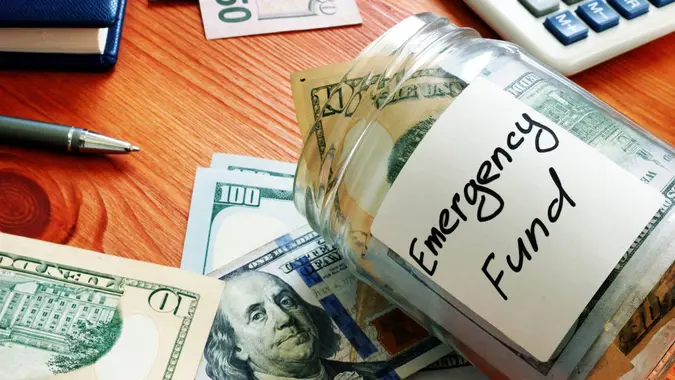How Much Should You Add to Your Emergency Savings To Keep Up With Inflation?

Commitment to Our Readers
GOBankingRates' editorial team is committed to bringing you unbiased reviews and information. We use data-driven methodologies to evaluate financial products and services - our reviews and ratings are not influenced by advertisers. You can read more about our editorial guidelines and our products and services review methodology.

20 Years
Helping You Live Richer

Reviewed
by Experts

Trusted by
Millions of Readers
Saving three to six months of emergency savings is a must, especially during times of economic uncertainty. However, rising inflation means that a $10,000 safety net might not be able to buy as much tomorrow as it does today.
GOBankingRates talked to financial experts to find out how much you should add to your emergency savings to keep up with inflation.
3% to 4%
Carson McLean, founder of Altruist Wealth Management, said individuals should aim to increase their emergency fund by 3% to 4% annually, assuming average inflation.
“For example, if your emergency fund is $30,000, aim to add an extra $900 to $1,200 each year, just to maintain its purchasing power,” McLean said.
Individuals can find the inflation rate by using the annual Consumer Price Index for All Urban Consumers published by the U.S. Bureau of Labor Statistics.
“Set an annual recurring calendar reminder to review the prior year’s inflation data and top up your fund,” McLean said. “Alternatively, set up an automatic savings transfer. For example, add $100 per month to your emergency account, which covers most inflation adjustments without much thought.”
The Exact Annual Inflation Rate
William Bergmark, a personal finance expert at Credwise, recommended that individuals use the annual inflation rate to calculate how much they should add to their emergency savings.
“For example, if you’ve saved $20,000 and inflation is 5%, you’ll have to put in at least $1,000 that year,” Bergmark said. “Inflation gradually erodes the purchasing power of your money — just letting it sit in the bank. So, it is a must to continuously build your emergency fund.”
One easy formula to calculate how much should be added each year to offset inflation is:
Emergency Fund Balance x Annual Inflation Rate = Adjustment Amount
Therefore, if an individual saved $15,000 in their emergency fund and the annual inflation rate is 2.9%, they should aim to save $435 ($15,000 x 0.029).
“Over the years, rising prices — especially on essentials like rent, groceries, gas and healthcare — can quietly outpace your savings,” Bergmark said. “Even if your fund was sufficient a few years ago, it might fall short today. It’s a hidden risk that many people don’t think about until it’s too late.”
Monitor Your Savings
To maintain an emergency fund, Jay Zigmont, founder and CEO of Childfree Wealth, recommended keeping the cash in a high-yield savings account and monitoring it every six months to ensure that one’s savings are keeping up with inflation.
“If your life and job are more stable, you can lean towards three months, if not go to six months,” Zigmont said. “Since it is based on your expenses, the amount needed will shift based on inflation and changes in your life.”
He suggested a “health check” on all your finances every six months. “Some people like using the first of the year and mid-year — July 1. Others check their finances twice a year when they change clocks. The key is to set a reminder on your phone and make it a habit.”
Use Savings Vehicles
Christine Lam, an investment advisor representative at the Financial Investment Team, said individuals should offset inflation by ensuring their emergency fund grows at a rate that matches inflation.
“This can be accomplished by utilizing vehicles such as high-yield savings accounts, certificates of deposit (CDs) or money market accounts,” Lam said. “To determine how much to save, review your monthly expenses and ensure that your emergency fund holds enough to cover three to six months’ worth of living costs.”
A simple way to keep track of savings goals is to earmark a percentage of one’s paycheck to go directly into an emergency fund account.
“This ensures consistent growth, and as your income increases, your savings will automatically grow proportionately,” Lam said. “At the end of each year, reassess your emergency fund, evaluate any changes in your financial situation and inflation rate, and adjust your savings goals if necessary.”
 Written by
Written by  Edited by
Edited by 
























